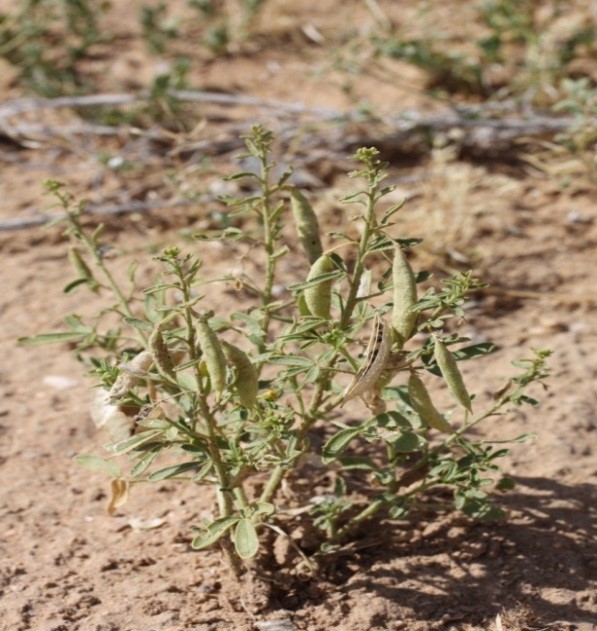
Cleome amblyocarpa / عفينة
Cleome africana
Khnezah, Afeenah, Atnah, Shajarat Wahsh, Magnoonah, Zeetah
Spider flower
Afeen, Afeenah
Capparaceae
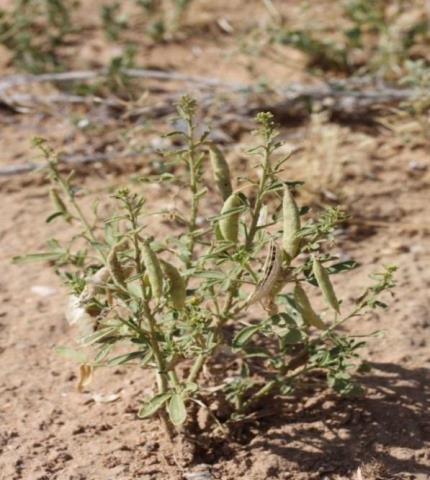
Aerial parts
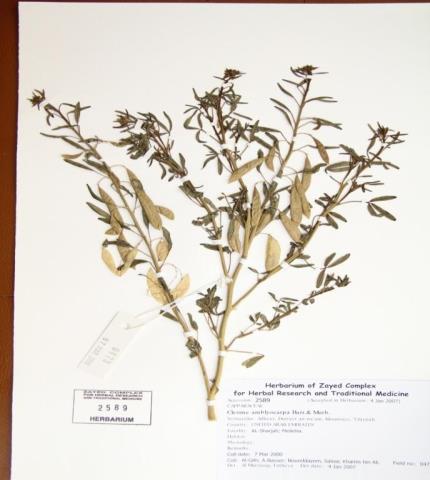
Herbarium specimen
Ethnobotanical Characteristics
Description
Erect perennial glandular, somewhat fetid herb, 50cm high, sometimes subfrutescent at the base. Leaves trifoliolate, with elliptical-oblanceolate leaflets, 4-25mm long, 2-5mm wide, one petioles about as long as the blade. Uppermost leaves sometimes simple, smaller. Flowers pedicelled, with a rather obscure corolla; petals white, broadly veined yellow, with purple-veined tips. Fruit a compressed, glandular, 2-valved capsule, 55mm long, 3-10mm wide, mucronate at apex, on pedicels 3-10mm long. Seeds densely covered with white hairs. (Mandaville 1990, Jongbloed, 2003).
Habitat and Distribution
Usually found in Arabian Peninsula; Egypt to Morocco. The plant is common in UAE in the sandy desert in the northern emirates.
Part(s) Used
Leaves & Arial Parts
Traditional and Medicinal Uses
Infusion of leaves has an almost immediate effect on abdominal and rheumatic pains (Loutfy Boulos, 1983).
Pharmacognosy and Phytochemistry
General appearance
The dried leaf is pale green, and it is lanceolate, but the dry leaf curls inwards, leaving the dorsal part to the outside. It is easily broken. At the top of the green plant, several leaves (3-4) are found in the form of a group.
Microscopic characteristics
A surface view of the leaf lamina shows an intricate network of venation and that both surfaces besides the entire margin of the leaf bear many glandular trichomes. These trichomes are short, and they have multicellular rounded heads and multiseriate stalks. Both epidermises consist of small polygonal cells. The upper epidermis bears many small rounded to oval anomocytic stomata. A transverse section of the leaf shows each epidermis to consist of one layer. The leaf is dorsiventral, and one palisade layer exists below the upper epidermis and, and it consists of small compactly packed cylindrical cells with rounded tips containing chloroplasts. The spongy mesophyll is differentiated into elongated cells with irregular shapes and thin cell walls, and they also contain chloroplasts. Spongy cells embed the vascular tissues whose vessels are annularly thickened.
Plant material of interest
Dried stem and branches
The stem is pale yellow and is almost quadrangular in cross-section with prominent longitudinal striations with slight protrusions. When held between fingers, the stem surface gives a coarse feeling. It branches at the internodes and when broken, it shows white internal tissues.
Microscopic characteristics
A transverse section through the stem shows almost a circular or semi-oblong cross-section. From the periphery inwards, the section shows the following: an epidermis consisting of polygonal cells, which exhibit small arch-like protrusions; the epidermis also bears a number of glandular trichomes with rounded heads and multiseriate stalks besides oval stomata; the light yellow-coloured multi-layered cortex, the outer layers consist of collenchyma cells while the inner layers consist of polygonal cells interrupted with groups of long lignified fibers; a few layers of compressed parenchyma cells surrounding a circle of heavily lignified vascular tissues with annularly and spirally thickened vessels; other layers of compressed parenchyma cells that surround the pith that consist of many comparatively large rounded cells.
Powdered plant material of the leaf
The material consists of a yellowish-green fine powder with an odour reminiscent of dried straw and an astringent bitter taste. Microscopically, the powder shows short glandular trichomes with multicellular heads and stalks bulging from leaf epidermis; some of them are also detached. The powder also shows leaf fragments rich in chloroplasts and other contents.
Powdered plant material of the stem and branches
The material consists of a dark greenish yellow homogeneous powder. It has a light odour reminiscent of dried straw and a slight some-what astringent acrid taste. Microscopically, the powder shows longitudinal fragment of the stems and branches that contain the grey-coloured fibro-vascular tissues. The vessels of the xylem are compactly arranged and they are spirally and annularly thickened. It also shows fragments of colourless polygonal epidermal cells and the almost rounded colourless pith cells with their obvious cell walls.
Parts studied
leaves and stem
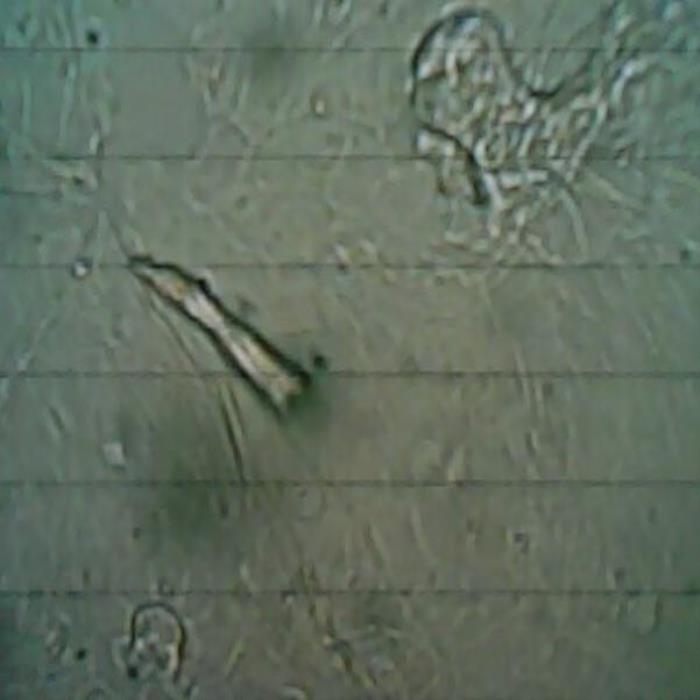
A) Surface view of leaf

B) Surface view of stem
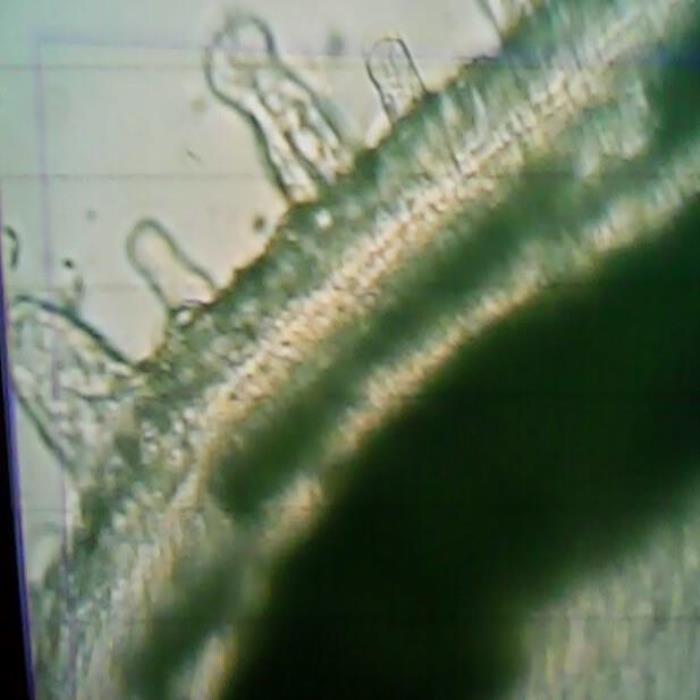
C) TS of stem
- A. A surface view of the leaf showing its small polygonal cells and a glandular trichome, which is short with a multicellular rounded head and a multiseriate stalk, quite characteristic of this plant.
- B. A surface view of the stem showing the epidermal polygonal cells to have small arch-like protrusions, oval stomata and a number of glandular trichomes similar to those of the leaf.
- C. A TS through a portion of the stem exhibiting the epidermal layer that bears a number of glandular trichomes, the light yellow outer layer of the cortex, which consists of collenchyma cells, the inner layer of cortex consisting of parenchyma cells interrupted with groups of long lignified fibers, layers of compressed parenchyma cells, heavily lignified vascular tissues, compressed parenchyma layers then the rounded cells of the pith.
Chemical constituents
The aerial parts of Cleome amblyocarpa yield dammarane-type triterpenes. Four new dammarane triterpenes: amblyone, cleomblynol A, isocleomblynol A, Cleomblynol B, and two known compounds, cleocarpanol and cabraleahydroxy lactone, were isolated from Cleome amblyocarpa aerial parts (Harraz, 1995). Cleome species showed the presence of 10 methylated flavonoids and eight flavonol glycosides (Sharaf, 1995). The CH3OH-CH2Cl2 extract of the aerial parts of Cleome amblyocarpa led to isolation of a new dammarane triterpenoid,15 alpha-acetoxycleomblynol A (Ahmed, 2001).
The following chemical studies have been carried out on the plant Cleome amblyocarpa (Quality Control methods, 1998; Evans, 1996) (ZCHRTM unpublished work):
Physicochemical constants
Loss of weight on drying at 105°C: 9.60
Absolute alcohol solubility: 8.00
Water solubility: 28.00
Successive extractives (%)
Petroleum ether (60-80)°C : 4.76
Chloroform : 2.15
Absolute alcohol : 9.07
Ash values (%)
Total ash : 13.50
Water soluble ash : 5.33
Acid insoluble ash (10% HCl) : 0.67
pH values (aqueous solution)
pH of 1% solution : 5.599-5.601
pH of 10% solution : 5.013-5.020
Elemental analyses
Ash values (British Herbal Pharmacopeia)
Assay and identification of element (AOAC International)
|
Apparatus |
AA-6800 Shimadzu-Flame method |
||||
| Element | Std. conc. µg/ml(ppm) | Sample conc.mg/ml | Samples absorbance | Actual conc.mg/ml | Actual conc. (%) |
|
Cr |
1, 2, 4 |
20.014 |
0.0016 |
0.01045 |
0.001045 |
|
Zn |
0.5, 1, 2 |
20.014 |
0.0878 |
0.0420750 |
0.0042075 |
|
Cu |
0.5, 1, 2 |
20.014 |
0.0138 |
0.006585 |
0.0006585 |
|
Fe |
1, 2, 4 |
20.014 |
0.2330 |
0.446655 |
0.0446655 |
|
K |
1, 2, 4 |
20.014 |
2.2704 |
1.2847600 |
0.128476 |
|
Pb |
1, 2, 4 |
20.014 |
0.0000 |
0.0000 |
0.0000 |
|
Cd |
0.25, 0.5, 1 |
20.014 |
0.0003 |
0.0000500 |
0.000005 |
UV Spectral studies
|
Sample conc.mg/ml |
Solvent used |
Max |
Min |
Remark |
|
5.02 mg\ml |
Intestinal Fluid simulated without pancreatic pH =7.5 ± 0.1 |
- ve |
- ve |
(225 to 400) |
|
1.02 mg\ml |
Gastric Fluid simulated without pepsin pH=1.2 ± 0.1 |
319 |
309 |
(225 to 400) |
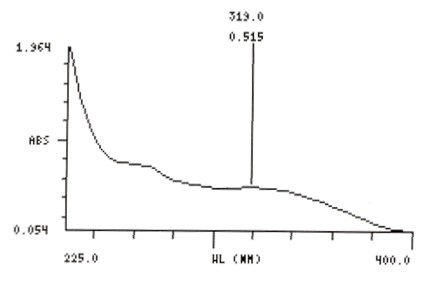
Gastric Fluid simulated without pepsin
Chromatographic Studies
Thin layer chromatography (Wagner and Bladt, 1996)

A
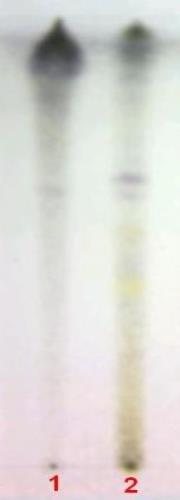
B
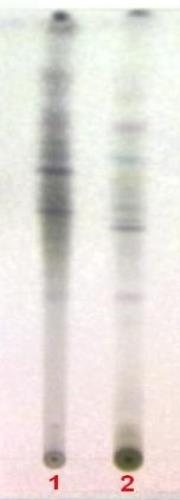
C
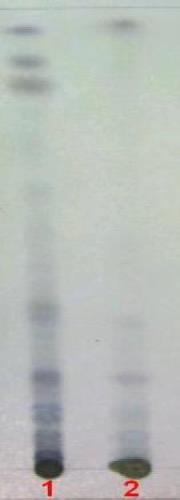
D
TLC fingerprint of Petroleum ether 60-80°C (track 1) and Methanol extract (track 2)
|
Mobile phase Fig. |
A&B |
: |
Toluene, ethyl acetate (93:7) |
|
|
C |
: |
Ethyl acetate, methanol, water (100:13.5:10) |
|
|
D |
: |
Toluene, ethyl formate, formic acid (5:4:1) |
|
Detection |
A |
: |
UV 254nm |
|
Derivatization |
B,C,D |
: |
Vanillin-Sulphuric acid-vis. |
Pharmacological & Toxicological studies
Antioxidant activity has been reported (Selloum, 1997). The plant has been reported to have diuretic and laxative activity (Bose, 2009). Cleome gynandropsis has been reported to have antibacterial activity (Perumal, 1999). The anti-inflammatory activity of Cleome arabica leaf extract was studied in-vivo and in-vitro. Firstly, the extract was examined for its anti-inflammatory activity using carrageenan-induced rat paw edema as a model of acute inflammation. The non-parenchymal cells might play an important role in the modulation of xenobiotic metabolism in liver and its pharmacological and toxicological consequences. Therefore, the role of cell-to-cell interactions in herbal induced liver toxicity was investigated in monocultures of cells from the human hepatocyte cell line (HepG2) and in co-cultures of cells from the HepG2 cell line, and cells from the human monocyte cell line (THP1). Cells were treated with various concentrations (1-500 microg ml/ml of extracts of Pistacia palaestina, Juglans regia and Quercus ithaburensis for 24 h. Extracts from Cleome droserifolia, a known toxic plant, were taken as positive control. In the co-culture system, toxic effects were observed after exposure to extracts of Pistacia palaestina and C. droserifolia. The extract significantly reduced the cell viability as measured the MTT test and the LDH assay (Saad, 2006).
The following pharmacological and safety evaluation of the aqueous extract of the plant Cleome amblyocarpa (Derelanko 2002; Han, 2003):
|
ACTIVITY |
RESULTS |
|||
|
Strong |
Moderate |
Mild |
Negative |
|
|
Analgesic |
|
|
√ |
|
|
Anti-inflammatory |
|
|
|
√ |
|
Cardiovascular |
|
√ |
|
|
|
Effect on isolated rat fundus |
√ |
|
|
|
|
Sexual effects |
|
|
|
√ |
|
Effect on rat fundus |
√ |
|
|
|
|
Effect on Guinea pig tracheal chain |
|
|
√ |
|
|
Antithrombotic effect |
√ |
|
|
|
|
Studies on biochemical parameters |
|
|
√ |
|
|
Studies on hematological parameters |
|
√ |
|
|
|
Locomotor |
|
|
|
√ |
|
Motor co-ordination (grip strength & motor activity |
|
|
|
√ |
|
Rectal temperature |
|
|
|
√ |
|
Body weight |
|
|
|
√ |
|
Vital organs |
|
|
|
√ |
|
Lethality |
|
|
|
√ |
Summary of the results
Aqueous extract of Cleome has significant Anti-nociceptive effect. It increased the systolic and diastolic blood pressure as well as heart rate at both the doses studied.

Effect on BP

Effect on HR
Cleome aqueous extract produced significant increase in resting tension of isolated rat fundus strip. The extract produced mild relaxation (~11%) in the histamine pre-contracted tracheal chain. The extract has no effect on the copulatory behavior of male rats. The extract appears to be not toxic at the doses studied. LD50 was calculated to be 4.067 g/ kg., orally.
Antimicrobial activity
The aqueous extract of the whole plant was tested against Mycobacterium smegmatis, C. tropicalis, different strains of Methicillin Resistant Staphylococcus aureus, different strains of ESBL-producing K. pneumonia, E. coli, Pseudomonas aeruginosa. The extract significantly inhibited the growth of Mycobacterium smegmatis only.
References
- Ahmed, A.A., Kattab, A.M., Bodige, S.G., Mao, Y.,Minter De, Reinecke MG., Watson, W.H., Mabry T.J.,(2001).15alpha-Acetoxycleomblynol A From Cleome amblyocarpa. J Nat Prod., 64(1), 106-7.
- Bauer AW, Kirby WMM, Sheriss JC, Turck M. (1966) Antibiotic susceptibility testing by standardized single method. Am J Clin Pathol; 45:493–6.
- Bose A Mondal. S, Gupta JK Dash GK Ghosh.T and Si.S. (2009). Studies on diuretic and laxative activity of ethanolic extract and its fractions of Cleome rutidosperma aerial parts. Pharmacognosy magzine Jadavpur University, Kolkata, 32.
- Boulos, L. (1983). Medicinal plants of North Africa. USA: Reference Publications Incorporated.
- British Herbal Pharmacopoeia (1996).4th Ed.: British Herbal Medicine Association (BHMA).
- Evans, W.C (1996).Trease and Evans’ Pharmacognosy,(14th ed,p.105 )Saunders ,London. Derelanko, M. J., & Hollinger, M. A. (2002). Hand book of toxicology. (2nd ed.). Boca Raton, USA: CRC Press.
- Han, J., & Hoosier, G. L. V. J. (2003). Hand book of laboratory science, animal models. (Second ed., Vol. II). USA: CRC Press.
- Harraz,F.M., Sevil,A.U., And Nur Tan.(1995). Dammarane Triterpenes From Cleome Amblyocarpa . Phytochemistry, 39(1, 175 - 178.
- Jongbloed, M., Feulner, G., Boer, B., & Western, A. (2003).The comprehensive guide to the wild flowers of the United Arab Emirates. Abu Dhabi, UAE: ERWDA.
- Quality control methods for medicinal plant materials (1998).World Health Organization, Geneva.
- Mandaville, J. (1990). Flora of Eastern Saudi Arabia. London, UK.:Kegan Paul International Ltd.
- Mothana R A A, Abdo SA ,Hasson S, Althawab FM, Alaghbari SA, Lindquist U.( 2008) Antimicrobial, antioxidant and cytotoxic activity and phytochemical screening of some Yemeni medicinal plants. Evid Based Complment Alternat Med. 7(3):323-30.
- Nagaya H, Tobita Y, Nagae T, Itokawa H, Takeya K, Halim AF, Abdel-Halim OB. (1997). Cytotoxic triterpenes from Cleome africana. Phytochemistry. 44:1115-9.
- Official Methods of Analysis of AOAC International (1999).16th. Ed.Vol.I and IIPerumalSamy R, Ignacimuthu S, Raja DP. (1999).
- Preliminary screening of ethnomedicinal plants from India.J Ethnopharmacol. 66:235-240.
- Saad B, Dakwar S, Said O, Abu-Hijleh G, Al Battah F, Kmeel A, Aziazeh H. (2006). Evaluation of medicinal plant hepatotoxicity in co-cultures of hepatocytes and monocytes. Evid Based Complement, Alternat Med, 3:93-8.
- Selloum L, Arrar L, Medani B, Khenchouche A, Bisker H. (1995). Effect of Cleome arabica leaves extract on inflammatory cells response in rat.BiochemSoc Trans. 23:609 S.
- Selloum L, Sebihi L, Mekhalfia A, Mahdadi R, Senator A. (1997). Antioxidant activity of Cleome arabica leaves extract. BiochemSoc Trans. 25:S608.
- Sharaf,M., El-Ansari,M.A., and Saleh,N.A.M.,(1997) .Flavonoids of Four Cleome and ThreeCapparis Species. Biochemical Systematics and Ecology, 25(2),161-166.
- Wagner, H. Bladt, S.(1996). Plant Drug Analysis-A Thin layer Chromatography Atlas, (2nd Ed.) Springer-Verlag, Berlin Heidelberg.
- ZCHRTM unpublished work
